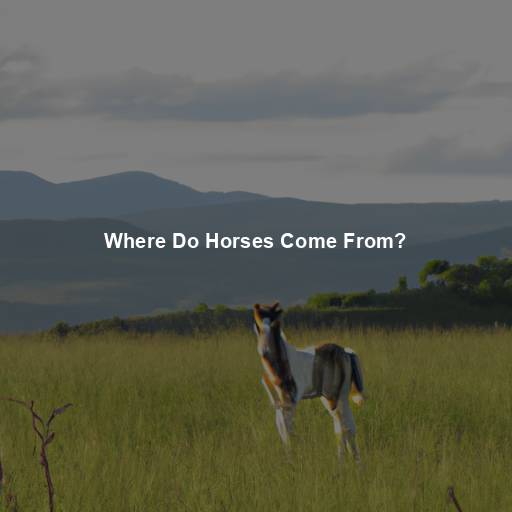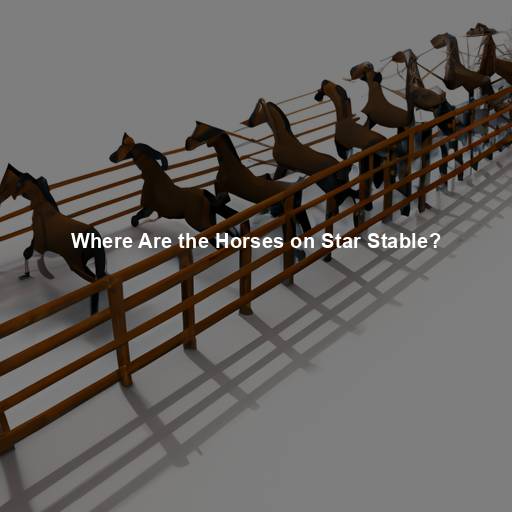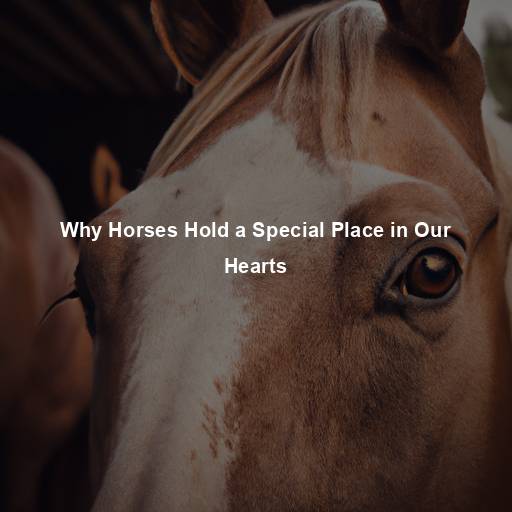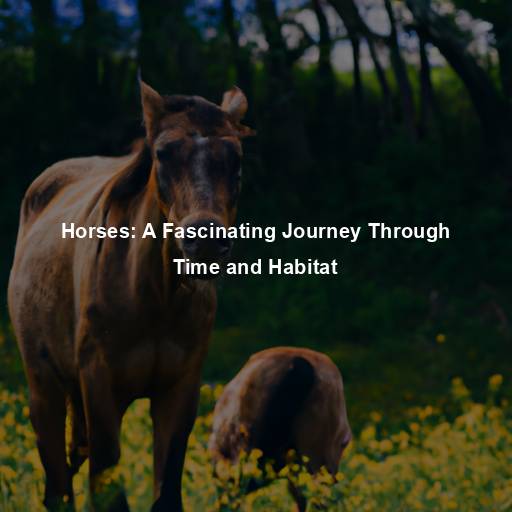Where Do Horses Come From?
Last Updated on July 22, 2023 by Evan
Contents
- 1 The Origins of Horses: A Historical Journey
- 2 The Journey of Horses Across Continents
- 3 The Evolutionary Marvel: Adaptations and Survival
- 4 The Enduring Bond: Horses and Humans
- 5 Exploring the Vast World of Horses
- 6 Caring for Horses: A Commitment to Well-being
- 7 Preserving the Legacy of Horses
- 8 The Everlasting Spirit of Horses
- 9 Equine Careers: A World of Possibilities
- 10 The Art and Science of Equine Nutrition
- 11 Ensuring Equine Health and Well-being
- 12 Cherishing and Protecting Horses
- 13 FAQs – Where do horses come from?
- 13.1 What is the origin of horses?
- 13.2 Where were the earliest horses found?
- 13.3 Did horses ever exist in the wild in other parts of the world?
- 13.4 When were horses first domesticated by humans?
- 13.5 How did horses spread across the globe?
- 13.6 Are there any wild horses today?
- 13.7 How have horses evolved over time?
- 13.8 Can all horse breeds be traced back to a common ancestor?
- 13.9 What is the importance of horses in human history?
The Origins of Horses: A Historical Journey
Horses have captivated mankind for centuries with their beauty, strength, and grace. They have played a significant role in shaping human history, serving as loyal companions, transportation, and even instruments of war. But have you ever wondered where these majestic creatures originated? Join us on a historical journey as we unravel the fascinating story of horse evolution.
The Dawn of Equids: Ancient Ancestors
Step into a time machine and journey back millions of years ago, to the majestic Eocene epoch. Picture a world where the enigmatic eohippus, affectionately referred to as the “dawn horse,” freely roamed the verdant forests of North America. These creatures, no larger than a loyal dog, gracefully frolicked with their four-toed front feet and three-toed hind feet. In an astonishing display of nature’s artistry, these primitive equids embarked on a remarkable journey of evolution, adeptly adapting to the ever-shifting landscapes that greeted them.
A Journey Through Time: From Forests to Grasslands
As the Earth underwent its breathtaking transformation, lush forests transformed into sprawling grasslands like an artist’s stroke on a canvas. In this enigmatic dance of change, an extraordinary chapter unfurled – the evolution of horses. Adapting to this perplexing shift, these majestic creatures embraced longer limbs, becoming fleet-footed champions of the vast open plains, while their teeth transformed into masterpieces of adaptation, perfectly suited for the delicate art of grazing on tender blades of grass.
The Mighty Equus: The Modern Horse
In the ever-captivating present day, we find ourselves face to face with the captivating Equus, a captivating genus that has captured the attention of both science enthusiasts and wild horse admirers alike. Within this captivating genus, we uncover an array of captivating species, ranging from the familiar domestic horse (Equus ferus caballus) to the untamed majesty of the Przewalski’s horse (Equus ferus przewalskii) and the spirited wild mustangs that roam the vast landscapes of America. Despite their visually captivating differences, it is their captivating kinship and membership to the Equidae family that unites these captivating creatures in a captivating tale of ancestry.
The Journey of Horses Across Continents
From North America to Eurasia: The Great Migration
The awe-inspiring tale of the horse’s wanderings unravels a fascinating tapestry of intercontinental migrations and an ancient fusion of worlds. Discovering their roots in the vast landscapes of North America, these majestic creatures embarked on a grand odyssey that spanned continents and forever altered the fabric of our planet. Delving through the annals of time, we stumble upon the Great American Interchange, a monumental event that reshaped the Earth, bridged North and South America, and opened the gateway for horse migrations towards the vast expanse of Eurasia.
The Eurasian Expansion: Horses Conquer the World
The majestic entrance of horses into Eurasia paved the way for a mesmerizing transformation in human societies. As these majestic creatures became an integral part of our daily existence, their domestication brought forth a cornucopia of implications ranging from the revolutionized modes of transportation to the unparalleled advancements in warfare and trade. Witnessing the awe-inspiring nomadic cultures like the Mongols, who harnessed horses’ raw power and galloped their way to build formidable empires, or delving into the pages of ancient Greek and Roman mythologies that revered horses as celestial beings dashing through chariot races – it becomes evident that the interplay between humans and horses birthed intricate narratives of undeniable complexity and enigmatic beauty.
Horses in the New World: A European Legacy
In a fascinating twist of fate, the majestic presence of horses was abruptly severed from the North American landscape millennia ago. However, with the arrival of bold European explorers, a captivating resurgence of these magnificent creatures unfolded. Like an enchanting tale from a time long forgotten, Spanish conquistadors seamlessly delivered horses to the New World during the remarkable 15th and 16th centuries, triggering an unparalleled transformation in the lives of Native American tribes. Overnight, these equine marvels became the lifeblood of Native American culture, endowing them with an incredible arsenal of hunting, traveling, and warfare prowess that left their counterparts in a state of awe and bewilderment.
The Evolutionary Marvel: Adaptations and Survival
Equine Adaptations: The Art of Survival
Horses have evolved a remarkable set of adaptations that contribute to their survival in diverse environments. Their keen senses, including exceptional eyesight and acute hearing, allow them to detect predators from afar. Additionally, their powerful leg muscles and hooves enable them to run at high speeds, evading danger in the wild.
The Domestication of Horses: A Profound Partnership
Throughout the annals of human civilization, there emerges a transformative saga that defies the boundaries of time – the domestication of horses. This captivating tale is said to have unfolded eons ago, in the mysterious lands of the Eurasian steppes, during the hazy epoch of 4000-3500 BCE. The symbiotic union between these majestic creatures and the human species sparked a whirlwind of perplexity, vaulting societies into an era of unparalleled growth – birthing agriculture, ushering commerce, and paving the way for a revolutionary means of traversing vast distances, transporting both precious cargo and weary souls.
The Enduring Bond: Horses and Humans
Horses as Companions: A Special Connection
Across the annals of time, the enigmatic allure of horses has woven a tapestry of unfathomable affinity with humankind. Beyond mere companionship, these majestic creatures have evolved into trusted confidants, forging an indelible bond teeming with mystery and profound kinship. Brimming with reverence and genuine devotion, the ethereal connection shared between humans and horses transcends the realms of pragmatism, grounding itself in an intangible tapestry of understanding, profound respect, and unconditional love.
Equine Therapy: Healing through Horses
Over the past few years, there’s been an intriguing surge in the recognition of equine therapy. Remarkably, engaging with horses has been revealed as an effective approach to alleviate stress, enhance self-worth, and offer comfort to those grappling with a wide array of obstacles like PTSD, autism, and anxiety disorders. The truly captivating facet is the remarkable intuitive and non-judgmental disposition of horses, which creates an unparalleled therapeutic encounter. It’s no wonder that equine therapy is making waves in the healing realm.
Exploring the Vast World of Horses
Horse Breeds: A Tapestry of Diversity
The world of horses is rich and diverse, with numerous breeds that showcase a wide range of characteristics and capabilities. From the elegant Arabian horse to the majestic Friesian, each breed possesses unique traits that make them suitable for specific purposes, be it racing, dressage, or ranch work.
Equine Sports and Competitions: A Thrilling Spectacle
Across the vast expanse of our planet, an international community of passionate individuals pays homage to the exquisite world of equine sports and competitions. With hearts pounding and spirits soaring, these devoted enthusiasts find themselves entranced by the unparalleled athleticism and boundless grace of these majestic beings. Whether it’s the thunderous gallop of hooves at the iconic Kentucky Derby or the mesmerizing choreography of dressage, these extraordinary spectacles forge unbreakable connections between riders and onlookers who share a deep-rooted admiration for the sheer splendor and unrivaled talent of these noble creatures.
Equine Assisted Activities and Therapies: Healing Hooves
In recent times, the world of Equine Assisted Activities and Therapies (EAAT) has witnessed a remarkable surge in popularity, captivating individuals across all age groups. This enticing realm offers a myriad of experiences, from the uplifting therapeutic riding to the captivating hippotherapy and the soul-nurturing equine-assisted psychotherapy. Within this dynamic ecosystem, the majestic horses take the center stage, unfurling a tapestry of physical, emotional, and psychological rewards. Their enchanting rhythmic movements have been known to kindle dormant fires, awakening balance, coordination, and muscle strength with each graceful sway, while the profound connection between rider and horse blossoms into an oasis of trust and emotional metamorphosis.
Working Horses: Partners in Productivity
In certain industries, horses continue to play a vital role in assisting with various tasks. In agriculture, draft horses are used for plowing fields and pulling heavy loads. Their strength and endurance make them well-suited for the demands of farm work. Similarly, in forestry, horses are employed to haul timber in areas where machinery is impractical.
Equine Careers: Pursuing Passion and Purpose
If you have a burning passion for horses, embarking on a journey in the equine industry will unveil a treasure trove of boundless possibilities. Whether you fancy the idea of becoming a seasoned equestrian or a masterful trainer, or even if your heart lies in the realm of veterinary medicine or equine therapy, the equine industry extends its branches to accommodate an array of vocations. Here, amidst this captivating world, horse aficionados can flourish and indulge in a myriad of professions tailored to their unique desires and aspirations.
Caring for Horses: A Commitment to Well-being
Equine Nutrition: Fueling for Performance
Proper nutrition is essential for maintaining the health and well-being of horses. A balanced diet, consisting of high-quality forage, grains, and supplements, provides the necessary nutrients for optimal growth and performance. Horses have unique dietary requirements, and it is crucial for owners to work closely with veterinarians and equine nutritionists to ensure their horses receive the appropriate feed and supplements based on their age, activity level, and overall health.
Equine Healthcare: The Well-being of Horses
Taking care of our horses’ health is of utmost importance, and that calls for regular veterinary check-ups. Vaccinations, dental care, and deworming are essential to prevent diseases and tackle any underlying health concerns. Proper hoof care, including trimming and shoeing, ensures the well-being and stability of our equine friends. It’s crucial for owners to stay cautious and observant, promptly reaching out to the vet if any signs of illness or injury arise.
Equine Exercise and Enrichment: Keeping Horses Active
Horses, those majestic creatures of boundless energy and enigmatic nature, breathe life into even the dullest of landscapes. Their innate need for movement and intellectual stimulation beckons us to unlock their true potential. Unleashing these magnificent beings into sprawling pastures offers them the freedom to graze, mingle, and revel in their innate behaviors. Yet, it is through the art of riding and training that the physicality of a horse converges seamlessly with the soul of its rider, forging an unbreakable bond.
Preserving the Legacy of Horses
Conservation Efforts: Protecting Wild Horses
The plight of wild horses, like the legendary mustangs that roam vast stretches of North America, remains a complex and ever-evolving struggle. As human expansion continues to encroach upon their habitats, these majestic creatures find themselves navigating a precarious existence. With the threat of vanishing forever, a symbiotic dance unfolds between conservation groups and government authorities, as they grapple with the perplexing task of safeguarding the future of these enigmatic creatures, allowing them to continue mesmerizing and captivating those fortunate enough to witness their untamed beauty.
Equine Rescue and Rehabilitation: Giving Horses a Second Chance
The unsung heroes of the equine world, rescue and rehabilitation centers, are the guiding light for horses in desperate need. Against all odds, these forgotten creatures find solace in the arms of these sanctuaries, where their shattered spirits mend and forgotten dreams ignite. Through a symphony of tender care, sweat-soaked training sessions, and an outpouring of affection, a miraculous transformation takes place, showing the world the indomitable spirit of these majestic beings. It is through the unwavering dedication of these centers that these horses reclaim their rightful place in the sun, inspiring us all with their story of resilience and redemption.
The Everlasting Spirit of Horses
Throughout history, horses have effortlessly etched themselves into the tapestry of human existence, their influence permeating our customs and civilizations. Their ethereal allure, unwavering might, and unwavering devotion consistently stir our souls, evoking a profound sense of wonder. As we revel in the indescribable connection shared by humans and horses, it becomes imperative that we safeguard the welfare of these astounding beings for future generations to relish. Whether they traverse boundlessly in the untamed wilderness or stand loyally beside us as steadfast companions, horses epitomize the essence of liberation, elegance, and unbridled magnificence.
Equine-Assisted Psychotherapy: Healing through Connection
Discover the transformative power of Equine-Assisted Psychotherapy (EAP), an innovative method that merges the gentle yet captivating presence of horses with the realms of healing and self-discovery. Through immersive activities with these empathetic creatures, individuals embark on a profound journey of emotional exploration, uncovering hidden layers of their psyche while cultivating a deep sense of self-awareness. The astounding ability of horses to intuitively reflect and respond to human emotions opens doors to incredible insights and personal growth, making each session an enigmatic and transformative experience.
Equine-Facilitated Learning: Discovering Personal Potential
Equine-Facilitated Learning (EFL) is an educational approach that utilizes horses as partners in experiential learning activities. Through interactive exercises, individuals can develop essential life skills such as leadership, communication, problem-solving, and emotional regulation. The presence of horses creates a dynamic and engaging learning environment, fostering personal growth and empowerment.
Therapeutic Riding: Empowering Individuals through Movement
Therapeutic Riding, also known as adaptive horseback riding, is a form of therapy that utilizes horseback riding to improve physical, cognitive, emotional, and social well-being. The rhythmic movements of the horse stimulate the rider’s muscles, promoting core strength, balance, and coordination. Beyond the physical benefits, therapeutic riding also enhances self-confidence, self-esteem, and social skills, as riders develop a bond with their equine partners and engage in a supportive community.
Equine Careers: A World of Possibilities
Equine-Assisted Activities and Therapy Professional: Making a Difference
Professionals in the field of Equine-Assisted Activities and Therapy focus on using horses as a tool for therapeutic and educational purposes. They may work as certified therapeutic riding instructors, equine-assisted psychotherapists, or equine-facilitated learning facilitators. These dedicated individuals combine their expertise in their respective fields with a deep understanding of horse behavior to create transformative experiences for their clients.
Equine Veterinarian: Ensuring Equine Health
Equine veterinarians possess a profound expertise in the realm of horse medicine, diligently tending to the welfare of these majestic creatures. Their multifaceted role encompasses a plethora of responsibilities – from granting preventive care and unraveling the enigma of equine ailments to offering reproductive assistance. Furthermore, their impact extends beyond the stables, as they actively contribute to the progress and evolution of equine medicine through groundbreaking research and innovation. In essence, these guardians of horse health embody a fusion of skill, dedication, and an unwavering commitment to these magnificent beings.
Equine Trainer: Nurturing Talent and Partnership
Equine trainers work with horses of various breeds and disciplines, preparing them for specific tasks or competitions. They possess a deep understanding of equine behavior and psychology, allowing them to develop effective training programs that build trust, respect, and cooperation between horse and human. Equine trainers may specialize in disciplines such as dressage, show jumping, western riding, or natural horsemanship, honing their skills to bring out the best in their equine partners.
The Art and Science of Equine Nutrition
Understanding Equine Nutritional Needs
When it comes to the well-being of our equine companions, one thing is clear: nutrition is key. Like any living creature, horses have unique dietary requirements that must be met for optimum health. Harnessing the power of fiber, horses thrive on a diet that incorporates hay and pasture, providing them with the necessary sustenance for growth, maintenance, and performance. A delicate balance of carbohydrates, proteins, fats, vitamins, and minerals is the secret recipe to keeping our majestic four-legged friends in top shape.
Feeding Strategies for Different Life Stages
Horses’ nutritional requirements vary depending on their life stages, activity levels, and individual needs. Foals, for example, require a diet rich in nutrients to support their rapid growth, while older horses may have specific dietary considerations to maintain their health and vitality. Pregnant and lactating mares also require additional nutrients to support the development of their offspring. Working horses, on the other hand, may benefit from specialized diets designed to meet their energy demands.
The Role of Forage in Equine Diets
Forage, such as hay or pasture, forms the foundation of a horse’s diet. It provides essential nutrients, aids in digestion, and promotes dental health. Horses have a natural grazing behavior, and access to forage mimics their natural feeding patterns, helping prevent boredom and digestive issues. The quality and quantity of forage should be carefully managed to ensure horses receive the necessary nutrients while maintaining a healthy body condition.
Ensuring Equine Health and Well-being
Preventive Healthcare for Horses
Taking care of horses is a complex and intricate task that demands diligence and attention. One must understand that regular veterinary care plays a vital role in ensuring the overall health and happiness of these majestic creatures. By administering vaccinations and adhering to rigorous dental care, horse owners can safeguard their animals against contagious diseases and maintain proper digestion. Additionally, a meticulous deworming protocol and routine hoof maintenance are fundamental in curbing internal parasites and promoting soundness and comfort.
Equine Exercise and Fitness
Maintaining the optimal health and happiness of our beloved equine companions relies on one fundamental mantra: exercise, exercise, exercise! A regular fitness routine ensures our four-legged friends are not only in top physical form but also mentally invigorated. By engaging in various activities like daily turnout and structured training sessions, horses can tap into their innate instincts and unleash their true potential. Let us never underestimate the power of a strong bond between horse and rider fostered through the magical combination of movement and mental stimulation!
Environmental Enrichment for Horses
Creating a dynamic and captivating atmosphere is absolutely crucial for the holistic well-being of our magnificent equine friends. By facilitating the opportunity for horses to engage in communal interactions, granting them ample access to lush pastures, and tantalizing their minds with captivating playthings or devious treat puzzles, we can ensure that boredom and monotonous behaviors cease to exist. This enriching environment offers a sanctuary where stress dissipates, mental faculties are invigorated, and horses can revel in their true potential, both physically and psychologically.
Cherishing and Protecting Horses
Preserving Endangered Horse Breeds
Some horse breeds face the threat of extinction due to factors such as declining populations, loss of habitat, or changing societal needs. Preserving endangered horse breeds is vital to maintain genetic diversity and protect the cultural heritage associated with these breeds. Conservation efforts, including breeding programs and public awareness campaigns, aim to safeguard these unique equine populations for future generations to appreciate and enjoy.
Responsible Horse Ownership
FAQs – Where do horses come from?
What is the origin of horses?
In the vast tapestry of our planet’s history, an enchanting transformation captured the essence of the horse we marvel at today. A captivating journey that spans millions of years unravels before us, revealing a distant ancestor known as Eohippus or Hyracotherium. This extraordinary creature, about the size of man’s loyal canine companion, boasted a mesmerizing symphony of small toes – four on its front feet and three on its hind feet. Pondering the perplexing evolution that led from that humble beginning to the majestic equines that grace our world now fills the mind with awe and wonder.
Where were the earliest horses found?
In the early chapters of Earth’s history, magnificent creatures known as horses galloped the vast expanse of what we now call the Great Plains. Fossil imprints, remnants of bygone eras, reveal that these ancient equines once roamed freely amidst the sprawling grasslands and towering forests of North America, approximately 55 million years in the past. As the eons unfolded, horses embarked on a remarkable journey, propelled by the forces of nature and the curious hands of mankind. Their hoofbeats echoed across continents, embracing new lands and weaving an intricate tapestry of equine heritage.
Did horses ever exist in the wild in other parts of the world?
Yes, horses existed in the wild in various parts of the world. Besides North America, wild horses were also found in Europe, Asia, and Africa. This wide distribution was possible due to the natural dispersal and migration of horses, as well as their domestication and transportation by humans throughout history.
When were horses first domesticated by humans?
Horses were likely first domesticated by humans around 4000-3500 BC in the Eurasian Steppe region, which includes parts of modern-day Ukraine, Kazakhstan, and Russia. They were initially bred for their meat and milk but quickly became highly valued for their ability to be ridden and carry heavy loads, revolutionizing transportation, agriculture, and warfare.
How did horses spread across the globe?
The majestic journey of horses traversing the Earth is a captivating tale of twists and turns. Through the enigmatic dance of migration, these wild beings embarked on a destined path, venturing across continents in a quest for sanctuaries that suited their needs. Yet, it was not solely the whims of nature that orchestrated this global symphony. The intricate interplay between humans and horses, fostered by acts of taming and commerce, had its hand in shaping the equestrian map. As mankind harnessed the equine power for transportation, farming, and military endeavors, it became the catalyst for the horses’ voyage to uncharted territories.
Are there any wild horses today?
Amazingly, amidst the perplexing vastness of civilization, the untamed spirit of horses still bursts forth in remarkable displays of wild magnificence. Take, for instance, the awe-inspiring North American mustangs, a captivating lineage tracing back to horses that dared to break free from their domestic confines, morphing into feral throngs that roam the sweeping landscapes with unparalleled grace. Equally captivating is the enigmatic Przewalski’s horse, known as the Mongolian wild horse, casting a spell of mystique across the untamed realms of Asia. Yet, be it in sports arenas, recreational settings, or the transformative world of therapy, it cannot be denied that most horses today have found solace in harmonious coexistence with their human counterparts, evoking a delicate tapestry woven between the wild and the civilized.
How have horses evolved over time?
Throughout their long and mysterious journey spanning millions of years, horses have embarked on a mesmerizing transformation that continues to baffle scientists. One particularly intriguing puzzle that unraveled was the gradual vanishing act of their side toes, leaving behind only a single majestic hoof as evidence of their ancestral past. Moreover, these remarkable creatures witnessed a perplexing growth spurt, escalating in size as if striving to conquer the challenges of survival and serve the ever-evolving needs of human companionship. The enigmatic evolution of horses stands as a testament to their ability to adapt and amaze, forever captivating our imagination.
Can all horse breeds be traced back to a common ancestor?
Yes, all horse breeds can be traced back to a common ancestor known as the wild horse, Equus ferus. This includes various breeds such as Arabians, Thoroughbreds, Quarter Horses, and many others. Regardless of their distinct characteristics and appearances, all domesticated horses belong to the same species, Equus ferus caballus.
What is the importance of horses in human history?
Throughout centuries, the majestic presence of horses has woven itself into the very fabric of our existence. Their boundless contributions to our history have left an indelible mark, spanning realms as diverse as transportation, agriculture, warfare, and leisure. With their graceful strength, horses ushered us into new frontiers, extending our reach across vast distances and enabling the cultivation of lands. Their innate ability to bear burdens, both physical and metaphorical, helped forge civilizations and ignite the flames of progress. Ploughing fields, carrying heavy loads, and empowering warriors on the battlefield, these magnificent creatures became integral players in our tumultuous human journey. As whispers of the past blend with the present, we still revel in the timeless bond we share with these loyal companions. Beyond their tangible contributions, horses continue to enchant us with their ethereal beauty, from the racetracks to the stables. We find solace and healing in their presence, as they mirror our emotions and embody the therapeutic power of connection. The horse, an emblem of strength and resilience, reminds us of our own capacity to transform and adapt. In a world full of uncertainties, these gentle giants stand as a symbol of unwavering companionship, sparking joy and inspiration in our hearts.







